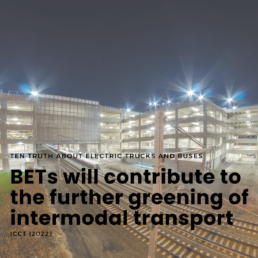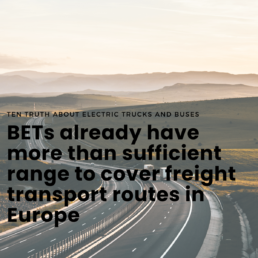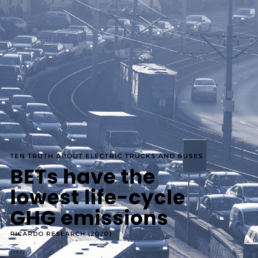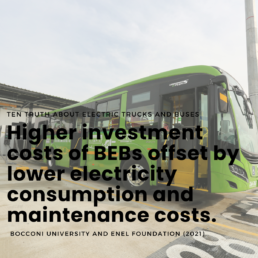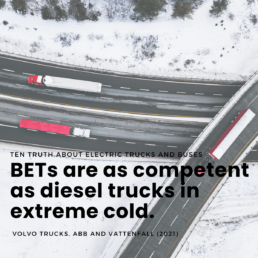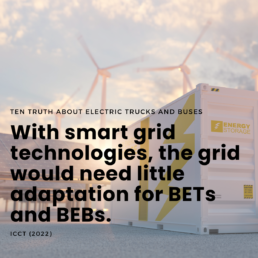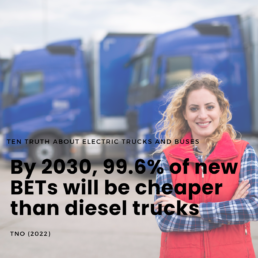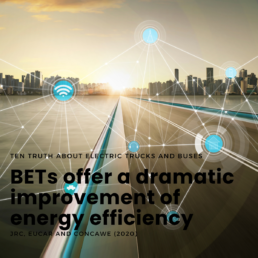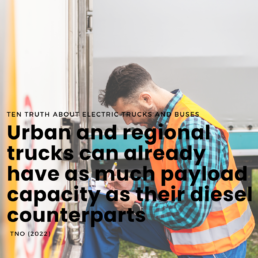[Video] Giovanni Matranga (ENEL Group) explains the CO2 Standards for HDVs
CO2 Standards for HDVs
Explained by Giovanni Matranga, chair of WG Logistics & buses
Is the CO2 Standards for HDV ambitious enough?
Givoanni: CO2 Standards are a crucial piece of legislation to make sure that heavy road transport will make its part to the achievement of the EU climate goals. New standards are undoubtedly needed to set the right pace and a clear trajectory for everyone: manufacturers, logistics operators and the whole supply chain.
For us the platform, considering the average lifespan of a truck of roughly 15 years, it’s imperative to respect climate goals that almost all newly registered trucks should be 100% zero emission by 2035.
Regarding urban buses, we welcome the Commission’s strong ambition, although some improvements must be performed for a proper transition to zero-emission buses in cities.
What about the new definition of zero-emission vehicle?
Giovanni: I am sorry that I may be a bit technical here, but a key point is the new definition of “zero-emission vehicle”, that would consider trucks and buses emitting 5 grams of CO2 per tonne-kilometer as zero-emission vehicles. In our platform view, this could create a dangerous loophole and allow the sales of polluting vehicles even after 2050 and lead to greenwashing practises.
How to know more?
Giovanni: If you are still watching this video, I have good news for you. On the 23rd of May, Members of the European Parliament, the European Commission and representatives of the trucks and buses industries will gather in a policy conference organised by the Platform for electromobility. Don’t miss your chance to participate in the discussion by registering on our website.
EUSEW Session: "Upskilling the EU’s industrial workforce to create clean energy systems for electric mobility"
All about the event and the skills for the transition
Want to know more?
event@platformelectromobility.eu
+32478700548
Program
16.30 – Welcoming
Théo Fievet - Coordinator, Platform for electromobility
16:40 – Panel discussion
Eric Feunteun, Ex. Vice-President, Software Republique
Tzeni Varfi, Principal, E.DSO
Patrik Kristanski, Chair of the Slovak Electric Vehicles Associations
Federic Fucci, Policy Officer at EuropeOn
Alex Keynes, Manager at Transport & Environment
17:30 – Discussion with audiance
Between 2021-2030, 42% of employees in the energy and mobility sectors will need training to assist Europe’s transition to a zero-emission mobility ecosystem. How best to achieve this for both workers and employers?
Emilia Valbum (3M) explains the Critical Raw Materials Act
Critical Raw Materials Act
The Platform's position introduced by Emilia Valbum
Why does Europe need a Critical Raw Materials Act?
Emilia: It is true that some Raw Materials exists in Europe, but we still remains way too dependent on third countries for mining, processing, refining and recycling. Those processes are very much done in resource-rich third countries, which more experienced and more competitive. This is endangering both Europe’s autonomy in CRMs but also the respect of our environmental standards.
And the current geopolitical events and supply chain tensions increase this dependency. But also create volatility, higher prices and uncertainties over global supply. This is why we welcomed on principle Commission’s Act.
Three clear flaws for Europe on CRMs
Emilia: We urgently need to ramp up a domestic Electric Vehicle value chain if we want to reach our climate goals. On this path, we identified three obstacles:
First, Europe should look beyond battery manufacturing to ensure access to resources themselves, and create capacity to refine, process, and recycle those resources.
The second flaw is the excessive hurdles to the permitting that can become counterproductive to defend social and environmental protection. And third obstacle is Europe’s incomplete and limited mapping of geological and remining potentials.
What are the solutions?
Emilia: At the Platform we identified twelve areas where we think the Act should change things up. I won’t cover them all now but a large part of the solution is to remove barriers to the reuse and repurposing of EV parts, which could extend the lifespan of critical raw materials prior to recycling, thereby reducing the overall demand for CRMs. I invite everyone interested to have a close look at our details recommendations.
Open letter to German Chancellor Scholz on CO2 Standards for cars and vans
Open letter
Industry and civil society call for certainty, ambition, and respect of co-legislators’ agreement on CO2 standards for cars and vans
Adressed to German Chancellor Olaf Scholz
Dear Chancellor Olaf Scholz,
The recent yet indefinite postponement of the vote on the CO2 Standards for cars and vans within the Council of the European Union has brought concerns to both business and civil society organisations alike.
With this open letter, the Platform for electromobility, uniting both spheres in a 47-member strong alliance to ensure the conditions for the full electrification of new light-duty vehicles by 2035, renews its support to the overall greenhouse gas emissions reduction target of 55% by 2030 and the climate neutrality objective by 2050. Reducing – and ultimately eliminating – emissions from cars, vans and trucks will be key to achieving these objectives.
As validated by the European Parliament in February, the cars and vans CO2 legislation will increase the offer and promote the market uptake of zero-emission vehicles. With an increased market, zero-emissions vehicles will also become more affordable with a continuously reduced total cost of ownership and more choice for consumers and will also help tackle air quality and noise issues, bringing an overall benefit to society.
The EU CO2 standards regulation delivers genuine benefits for transport, ensuring planning and investment certainty, setting clear signals to not only car makers and consumers but also to EV infrastructure providers on the required pace for the transition to zero-emission mobility. However, recent political backpedalling has severely blurred those signals to European industries, investors and infrastructure providers as well as the legal certainty formerly established by the EU’s institutional procedures.
The Platform for electromobility thus urges the Swedish Government, as President of the Council, to first provide clarity and certainty on the agenda and secondly to safeguard the agreement as was already agreed in good faith between the EP and Council. Reneging on this deal not only puts at risk the EU Green Deal’s goal to fully decarbonise road transport by 2050, but undermines the very credibility of the EU’s established democratic norms.
Sincerely yours,
Policy Conference: "How to get Europe ready for electric trucks and buses?"
The Platform for electromobility and MEP Bas Eickhout organise a debate between policy makers and major stakeholders to discuss the decarbonisation of trucks and buses in the context of the CO2 Standards for heavy-duty vehicles. Register not to miss the opportunity to hear everyone’s position at what will be a crucial moment in the legislative process.
At this Platform’s discussion, we will take a closer look at the proposal and what kind of path it paves to decarbonize trucks and buses.
More information on agenda and speakers will be communicated shortly
Date & Time
23th May 2023
European Parliament
15:30
Contact
event@platformelectromobility.eu
+32 4 78 70 05 48
Program
- 15.30 – Welcoming
- David Keating – Moderator
- Bas Eickhout – MEP, Greens/EFA
- Julia Poliscanova – 2023 Platform Vice-Chair, T&E
- 15:45 – Keynote speaker
- Beatriz Yordi – Director DG Clima , European Commission
- 15:55 – Panel on truck transition
- Jennie Cato – Head of Global Public Affairs at Scania
- Philippe de Carne – CEO at Geodis
- Dirk Jan van de Ruiter – Global Logistics Director at Unilever
- Koen Noyens – Head of Public Affairs at Milence
- 16:45 – Panel on bus transition
- Representative of city authority – TBC
- Karsten Wasiluk – Manager e-bus at Daimler Trucks
- Simone Manca - Head of e-Bus – EnelX
- TBD – German Association of Energy and Water Industries
- 17.15 – Closing remarks
- Bas Eickhout – MEP, Greens/EFA
- 17.30 – Networking drinks and appetizers
Our position on CO2 Standards for HDVs
The revision of HDV CO2 standards should align the CO2 targets for the sector with those of the EU’s overall 55% GHG reduction target in 2030 and the climate neutrality target of 2050.
Ten truths about electric trucks and buses
Lice-cycle GHG emissions
Battery electric trucks have the lowest life-cycle GHG emissions
This is true from 16-40t trucks, according to a study by Ricardo Research (2020), which compared emissions of the differing drivetrain technologies based on a WTW approach. The emission-saving potential of electric vehicles (EVs) increase when entirely powered by renewable energy (up to 81%) compared to a fossil-powered alternative as shown by study ICCT (2021) undertaken in passenger cars. As battery-eletric trucks (BETs) have outstanding energy efficiency, lifecycle emissions decrease with every additional kilometre driven, meaning that long-distance trucks have particularly high emission-saving potential.
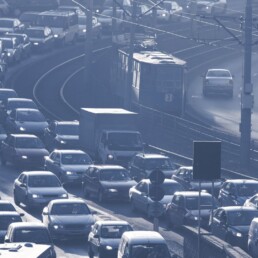

Energy efficiency
Battery electric trucks offer a dramatic improvement of energy efficiency
BETs offer a dramatic improvement of energy efficiency, i.e. the ability to drive a greater number of kilometres on the same amount of energy. The JRC, EUCAR and Concawe (2020) have updated their joint evaluation of the WTW energy use and Greenhouse gas (GHG) emissions for a wide range of powertrain options. Considering only zero-emission technologies on Wheel-to-Well (WTW) basis, BETs using green electricity - both regional and long-haul - are 2.6 times more energy efficient than the green hydrogen-powered fuel cell equivalent. Although synthetic fuels were evaluated for cars rather than trucks, as an indication a battery electric car using green electricity is 6.9 times more energy efficient than a combustion vehicle using e-fuel.
GHGs and air pollutant
Battery electric buses do not produce local GHGs and air pollutant emissions
Battery-electric buses (BEBs) do not produce local GHGs and air pollutant emissions, providing considerable health benefits, particularly in cities. Because they are powered by electricity, the higher powertrain efficiency means that BEBs emit 73% less CO2 equivalent than diesels, rising to 90% if powered by 100% renewable sources. In contrast (according to ICCT (2022)),Compressed Natural Gas (CNG) CO2 emissions are nearly 30% lower than a diesel, but its higher energy consumption - 24-50% per kilometre - reduces this advantage. In addition, methane is a potent GHG with a global warming potential more than 80 times greater than CO2 over a 20-year period; unintended leakages during extraction and transport further exacerbate the situation.
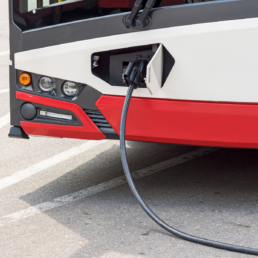

Intermodality
BETs will contribute to the further greening of intermodal transport
BETs will contribute to the further greening of intermodal transport, as well as improving the overall energy efficiency of freight logistics. Synergies between rail, road transport and inland waterways are crucial to the logistics system. These offer benefits for the whole supply chain, as intermodal transport helps reduce congestion in urban areas while potentially increasing capacity in and around cities. Tangible examples of intermodal links have been successfully deployed in Paris’ metropolitan area. Companies such as IKEA and Franprix supply stores in Paris are using a combination of electric ships and electric road transport solutions for the last-mile segment.
Electricity grid
With smart grid technologies, the grid would need little adaptation for BETs and BEBs.
With smart grid technologies, the grid would need little adaptation for BETs and BEBs. Uni- and bi-directional charging enables a double optimization of the load at the depot. Optimising the grid connection and allowing the monetisation of the vehicles' flexibility capabilities makes them valuable assets, even when parked: it also provides the grid with supplementary battery capacity. Vehicle-to-grid (V2G) is performed at much lower power levels than in regenerative braking or fast charging.
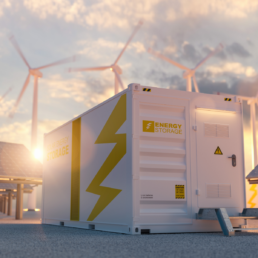

Cost
By 2030, 99.6% of new BETs will be cheaper to own and run than diesel trucks
By 2030, 99.6% of new BETs will be cheaper to own and run than diesel trucks while carrying the same weight of goods over the same distance and journey time, according to a study by TNO (2022). This study is based on the total cost of ownership (TCO), the most important economic indicator for a truck. It covers those deployed in urban and regional delivery over distances of 300 km as well as long-distance trucks travelling 800km/day. Due to the savings from using electricity rather than diesel, the cost-saving potential of BETs increases with every additional kilometre driven, meaning that by 2035, long-distance trucks will be the most cost-efficient solution in Europe.
Investment costs of battery elecric buses
Higher investment costs of BEBs offset by lower electricity consumption and maintenance costs.
Similarly, the higher investment costs of BEBs are offset by their lower electricity consumption and maintenance costs (in Spain and Latin America in 2021 and in Italy, US and UK by 2023). Bocconi University and Enel Foundation (2021) integrated well-known TCO (the initial investment in purchasing vehicles and the charging infrastructure, plus the operational and maintenance costs) with peculiar to BEBs circular economy revenue streams, by the second life of batteries and V2G. This explains why buses are now the fastest-growing zero-emission vehicle segment, making up 23% of new city buses in 2021, up from 16% in 2020. Considering the revenues from V2G and second life, BEBs are more cost effective than diesel and CNG buses.
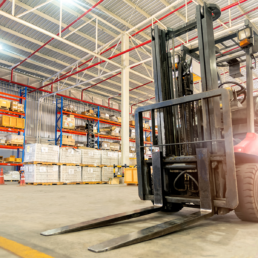
Payload
Urban and regional trucks can already have as much payload capacity as their diesel counterparts
Urban and regional trucks can already have as much payload capacity as their diesel counterparts today, according to a recent study by TNO. While the battery of an electric long-haul truck currently may weigh several tonnes, depending on its size, the so-called 'ZEV weight allowance' grants an additional two tonnes to zero emission trucks on European roads. This, along with improving vehicle energy efficiency and battery energy density, will eliminate any payload loss by the end of the decade, even for long-distance trucks with 800km range.
Range
BETs already have more than sufficient range to cover freight transport routes in Europe
BETs already have more than sufficient range to cover freight transport routes in Europe, something that will continue to improve. With the compulsory 45-minute break every 4.5 hours, and given that they have a maximum permitted speed of 90km/h, trucks will never drive more than 400 km without having to stop. Tesla has begun deliveries of the ‘Tesla Semi’, a clean-sheet design BET with a real-world range of 800km when fully loaded. The EU’s Weights & Dimensions Directive allows ZETs to be increased by two tonnes over that of diesel trucks. This allowance alone already increases the payload-neutral range of electric trucks by over 300km.


Extreme conditions
BETs are as competent as diesel trucks in extreme cold.
BETs are as competent as diesel trucks in extreme cold. In February 2021, Volvo Trucks, ABB and Vattenfall - together with a local mining company - ran a trial on replacing the diesel transport of iron ore with BETs. The ore is taken from a North Sweden mine to the railway transfer station, in temperatures of -30C°. The BETs were used for the journey from the mine to the transfer station where they could unload the cargo while recharging batteries following a 280km round trip normally undertaken by diesel-powered vehicles. The Polar Winter Project proved the feasibility of electric transportation in extreme conditions. The BETs were able to drive the entire distance - including 140km with 14t of ore on board, at temperatures as low as -32C° - while taking the same amount of time as the diesel trucks.
BET Battery Electric Truck
GHG Greenhouse Gas
EV Electric Vehicle
WTW Wheel-to-Well
BEB Battery Electric Bus
CNG Compressed Natural Gas
V2G Vehicle-to-Grid
HDV Heavy-Duty Vehicle
LFP Lithium iron phosphate
TCO Total Cost of Ownership
ZEV Zero-Emission Vehicle
ZET Zero-Emission Truck
JRC Joint Research Center
CO2 Standards for HDVs: Our open letter to Commissioner Breton to boost clean tech industries
Open letter
Cleantech companies and civil society see ambitious truck CO2 standards as catalyst for growing EU supply chains
Adressed to Commissioner Thierry Breton
Dear Commissioner Breton,
We, a large group of industries and civil society organisations stakeholders from the freight, e-mobility and clean tech supply chain, welcome your efforts to respond to the U.S. IRA and boost investments into sustainable and clean European technologies. As we are actively working on the decarbonisation of our industry branches, we fully support the targets of the European Green Deal and Europe’s 2030 and 2050 climate targets.
The Smart & Sustainable Mobility Strategy sets a clear goal for Europe to reduce transport emissions by 90% in 2050. Decarbonising freight transport will require reducing its dependency on fossil fuels, shifting a larger share of traffic to more sustainable transport modes and finally through the internalisation of external costs. The upcoming CO2 performance standards for heavy-duty vehicles (HDV) will stimulate the investments required to achieve the first of these objectives. Cleantech in the EU road freight and heavy-duty vehicle infrastructure sectors is in the early stages. By mirroring the new targets for trucks to the blueprint Europe has just set out for its automotive sector, these sectors can surf on and amplify each other’s supply chains. Mandating around half of new trucks to be zero emission from 2030 and almost all of them from 2035 will shore up demand for battery cells made in EU gigafactories and staffed with EU workers. A balanced policy mix matches increased governmental investment support with such greater demands from, and clarity on the shared end goals for, our EU industries. This will help greening homegrown EU freight sector that can compete with, and ultimately again overcome, competition from across the oceans.
Today, zero-emission trucks are still produced in small numbers. Ambitious standards for trucks can achieve what has been done for cars: seriously scaling up the supply, thereby bringing down the cost per unit. Whilst the CO2 standards as a regulatory tool safeguard the roadmap for a rapid green transition, the subsidies funnel money directly into the sustainable freight and mobility solutions to enable and ensure a thriving European clean tech industry. That way all actors, especially smaller and medium-sized companies, remain competitive and can be part of Europe’s green transition.
We, the undersigned organisations, see ambitious CO2 targets for trucks as an essential means to ensure EU cleantech investments are boosted and channelled into sustainable road freight technologies. This complements the parallel push to switch traffic to more sustainable modes of transport and the internalisation of external costs. Green technologies – from renewable energy to battery production – will secure and provide jobs in Europe, now and in the future. Strong CO2 standards provide certainty to our European industries in a challenging and changing world. And they utilise the momentum of progressive frontrunners that have shown electric trucks are part of Europe’s flagship clean technologies.
EPBD: 3 Pillars to ensure the private charging of EVs
3 Pillars to ensure the private charging of EVs
As 90% of all charging takes place at home or in the workplace and 80% of the EU’s current building stock will still be in use by 2050, private charging is key to the growth of electromobility. Only an ambitious revision of the EPBD (Art. 12) can make it happen.
for multifamily dwellings
Pre-cabling
If a building is not pre-cabled in the construction or major renovation phase, it can be 9 times more expensive to install cables in the latter stage. It'd lead to highly cumbersome discussions with project developers which can take over 6 months in problematic cases to install a charging station. The pre-cabling should cover both technical and electrical installations for the seamless future installation of recharging points.
for users and grid
Smart functionalities
Smart charging (uni- and bi-directional) can reduce one-third of the EV users' electricity bill. Moreover, it would facilitate the integration of the renewable energies into the grid, reduce the electricity consumption during peak hours and provide flexibility services to the system.
For existing buildings
Right-to-plug
Those advantages would not be reached without removing administrative barriers to installing a charging station, especially the delays in multifamily buildings. Time between application and installation should not exceed 3 months.

